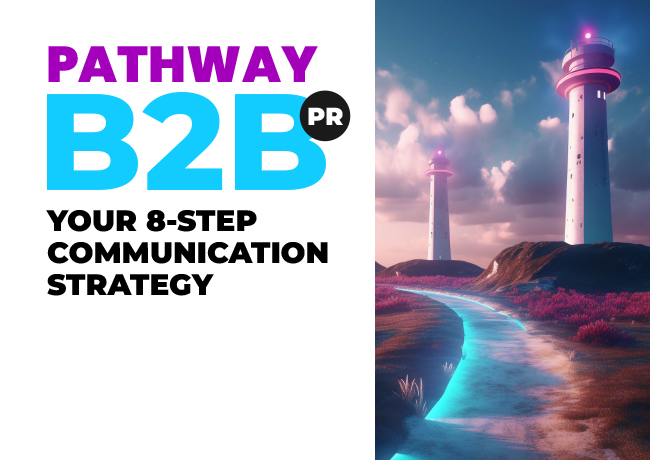
Seven steps to creating a strategic PR plan
A well-structured PR strategy plan can help you move beyond rushed press releases and piecemeal media placements to get real results from your PR efforts.
In this guide, we’ll walk you through the essential steps to crafting an effective PR strategy. You’ll learn what a strategic PR plan entails, explore a step-by-step process for building your own, and gain insights from real-world examples.
Whether you’re looking to raise brand awareness, establish thought leadership, or generate high-value media coverage, this framework will help you create a PR plan that delivers lasting results.
Discover the key principles to writing a strategic PR plan, including:
What is a strategic PR plan?
A strategic PR plan is a structured plan that outlines how an organisation will communicate with its target audience to build and maintain a positive reputation. It defines key messaging, identifies the most effective communication channels, and aligns PR efforts with business objectives. A well-crafted PR strategy ensures that all public relations activities—such as media outreach, thought leadership, events, and digital content—work together to shape public perception, enhance credibility, and support long-term growth.
Seven steps to creating your strategic PR plan
Set a benchmark
The first step in the strategic PR planning process is to set a benchmark and review why you are where you are in terms of brand awareness and marketing performance. Start by benchmarking the strength of your brand in the marketplace with a brand audit, and ensuring you have a clear communications strategy in place.
From here, you can map out previous media coverage, take note of successful story pitches from the past, and consider the strength of existing relationships with journalists, bloggers, and other media figures.
Aside from editorial media, analyse the strength of your web content and social media to get a sense of what is working and what needs to be changed. Platforms like Google Analytics and Hootsuite can help you pinpoint content that is performing well and determine the qualities that helped it to appeal to your audience.
2Define your PR goals and objectives
Setting your PR goals and objectives will be more effective with a clear idea of how previous campaigns have performed and you can decide whether you want to extend PR activity in a similar direction, or find a new approach.
Your overarching goals should be firmly aligned with a business and marketing plan — be this supporting the introduction of new products, expanding into a new area, establishing your expertise, raising brand awareness, or just boosting your bottom line.
These goals should then be distilled into specific and measurable objectives, such as increasing web traffic, getting coverage in top tier publications, or boosting your social media presence by gaining a certain number of engaged followers.
Consider tying your goals to the SMART framework – Specific, Measurable, Achievable, Realistic, and Timely.
To set measurable goals, you will need to consider how to track the results of your campaign. This might mean looking to specific metrics like the number of articles placed in top tier media publications, orders for a new product or service, mentions on social media, website traffic, or the amount of press clippings that mention your company.
3Determining the target audience for ‘this’ PR campaign
Determining who the target audience is for your PR campaign is a critical decision. With your goals and objectives in mind, consider the decision-makers that can turn the tables of fortune in your direction — the individuals, groups and communities that have the power to choose your product or service.
Examine the demographics, psychographics, and digital behaviour of your ideal buyer, and create buyer personas. The more you know about your target audience, the more you can tailor your strategy to be effective.
Location
Are they city slickers or country bumpkins? Knowing where your audience resides will help you pitch stories to the right publications, and tailor online content to the right locality.
Media habits
Do they read specific paper publications, or prefer to digest content online? Understanding the type of media your target audience engages with will tell you which media figures are worth pitching stories to.
Characteristics
What interests do they share? Knowing what makes your target audience tick can help you identify what sort of messages are likely to resonate with them.
4Create key compelling messaging
With a clear idea of your target audience, you can craft compelling messages to provoke thoughts, words, or deeds.
The brand voice, language, and approach of your messaging will form the backbone of your campaign and guide all the content you create — whether that’s a pitch, press release, or social media campaign.
This messaging needs to reflect what the PR campaign is trying to achieve, and it should be concise, easy to understand and memorable. The messaging should also mesh with other marketing and communications activity including advertising.
5Match your message to the media channel
You need to match your message to the media channel to secure the greatest impact. Once you have your key messaging, you can determine the type of content and preferred distribution platforms.
Find the paper publications and the digital stomping grounds of your target audience, decide which ones you will use to disseminate your message, and begin to build a media list.
Your choice of channel should be based on your target audience. Bear in mind that demographics can change, with audiences across social media channels constantly in flux as the services evolve, and traditional magazines pivoting over time to attract different groups of people.
Thought leaders are respected for their depth of knowledge while Influencers are generally admired for their celebrity. Find out what might suit you best in our article: Thought leader vs Influencer – what’s the difference?

6Distribute your editorial
You need to distribute your editorial to named journalists who have an interest in your subject matter. Once you have a small number of focused channels, check the editorial calendars of your target publications — whether mainstream media or digital creators — and consider the pitching deadlines in advance to create a content schedule.
The ideal schedule will consist of content published at regular intervals throughout the year. Consistent media coverage is more beneficial than singular events, creating a steady stream of engagement that draws more leads into the top of the funnel and boosts growth.
7Measure the success of your strategic PR plan
Don’t forget to measure the success of your strategic PR plan! This final step is crucial for understanding what worked, what didn’t, and how to refine your approach for future campaigns. Just as the process begins with setting clear objectives, it should end with a thorough review of results to determine whether those goals were met.
Start by compiling data from various sources, including media coverage, website analytics, social media performance, and audience engagement metrics.
Beyond numbers, qualitative insights matter too. Gather feedback from stakeholders, customers, and media contacts to assess the perception and effectiveness of your messaging. Was your brand story compelling? Did journalists respond positively to your pitches?
Once the data is collected, compile it into a comprehensive report that outlines successes, challenges, and areas for improvement. This report will serve as a blueprint for refining future PR strategies, ensuring that your next campaign is even more effective in achieving your business objectives.
An example of PR strategy
Objective
Position AI CyberShield as a leading AI-driven cybersecurity solution, increase brand awareness, and generate leads among enterprise IT decision-makers.
Target Audience
CISOs (Chief Information Security Officers), IT security managers, tech journalists & analysts, enterprise decision-makers in finance, healthcare, and government sectors
Key Messages
AI-driven threat detection – proactive cybersecurity with real-time threat analysis.
Industry-first innovation – the only solution with adaptive learning to predict and prevent cyberattacks.
Enterprise-grade security – scalable, compliant, and built for high-risk industries.
PR Tactics & Activities
Press release & media outreach: Announce the product launch, highlighting key innovations.
Target top-tier tech and cybersecurity publications (e.g., TechCrunch, Wired, Dark Reading).
Offer exclusive interviews with company executives.
Thought leadership & content marketing: Publish expert articles on AI in cybersecurity. Secure guest posts in industry blogs and online tech magazines. Position the CEO for keynote talks at cybersecurity conferences.
Analyst & influencer engagement: Brief industry analysts (e.g., Gartner, Forrester) on the product’s value proposition. Collaborate with cybersecurity influencers for product reviews and webinars.
Social media & digital PR: Launch a LinkedIn campaign with case studies and testimonials.
Share product insights and security tips on Twitter/X and Reddit cybersecurity forums.
Run a live Q&A session with the product development team.
Webinar and events: Host a virtual launch event with live demonstrations.
Sponsor cybersecurity summits and participate in panel discussions.
Crisis & reputation management: Prepare a crisis communication plan for potential product vulnerabilities. Monitor media coverage and address concerns proactively.
Measurement & KPIs
Media coverage – Number of articles, interviews, and media mentions.
Brand awareness – Growth in website traffic and social media engagement.
Lead generation – Inbound inquiries and demo requests.
Analyst recognition – Inclusion in reports and vendor lists
Frequently Asked Questions
1. What is a digital PR strategy?
Digital PR is essentially the evolution of traditional public relations, adapted for the online world. It leverages digital channels and tactics to build brand awareness, enhance reputation, and drive online visibility.
A key focus of digital PR strategy is building relationships and securing coverage in online publications, blogs, and social media platforms. As part of this SEO integration is essential with high-quality backlinks and keyword targeted articles helping to improve search engine rankings.
Content creation is another crucial component, with articles, infographics, and videos driving attention. Social media engagement enables interaction with audiences, building communities, and amplifying brand messages. Additionally, influencer marketing further enhances reach and credibility by partnering with key online figures.
Lastly, data and analytics are integral to tracking performance, measuring results, and refining strategies for continuous improvement.
2. What role does crisis management play in a PR strategy?
Crisis management is a crucial part of any PR strategy, ensuring businesses can respond quickly and effectively to negative events. A well-prepared crisis communication plan helps protect brand reputation by addressing issues transparently, mitigating damage, and restoring public trust.
Effective crisis communication involves preparing for potential risks, establishing a clear chain of command, and ensuring that spokespersons are trained to handle media inquiries.
3. How often should a PR strategic plan be updated?
A PR strategic plan should be reviewed at least annually or whenever significant changes occur in your business, industry, or media landscape. Regular updates ensure it remains relevant and aligned with evolving goals.
Need help with your PR strategy?
To start forming your strategic public relations strategy, reach out to our specialists today. And if you found this article valuable, read our guide to PR Campaign Planning or download the complete guide here.
Or, if you’d just like to stay in touch – sign up here to receive regular insights on how to make your PR work harder.
Subscribe to our updates
Stay up to date with the latest insights, case studies and PR guides.

Your 8-Step Communication Strategy Guide
A comprehensive guide to delivering your business goals using intelligent and relevant messaging.

